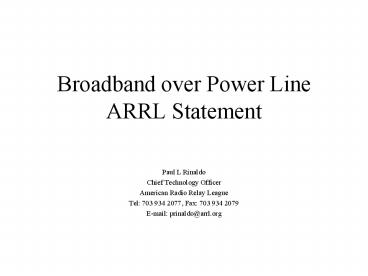Broadband over Power Line ARRL Statement PowerPoint PPT Presentation
1 / 11
Title: Broadband over Power Line ARRL Statement
1
Broadband over Power Line ARRL Statement
- Paul L Rinaldo
- Chief Technology Officer
- American Radio Relay League
- Tel 703 934 2077, Fax 703 934 2079
- E-mail prinaldo_at_arrl.org
2
Who is ARRL?
- Represents 160,000 members, licensed amateur
radio operators mostly in USA - ARRL is a member society of the International
Amateur Radio Union (IARU) which represents 2.6 M
amateur radio operators - ARRL, IARU active in ITU-R SG 1 studies.
3
ARRL on Broadband
- ARRL endorses universal, affordable access to
broadband technology. - BPL has the potential of interfering with radio
services, particularly amateur radio - Interference has occurred, complaints filed with
FCC, have resulted in shut down of systems (e.g.
Cedar Rapids, IA)
4
FCC ET Docket No. 04-37
- On Feb 23, FCC released Notice of Proposed Rule
Making on BPL. - NPRM would permit BPL at Part 15 emission levels
for intended emitters, e.g., 30 µV/m measured at
30 m distance. Proposes inadequate mitigation
procedures.
5
NTIA Report 04-413
- NTIA report of April 27 addresses potential
interference to federal assignments - For low/moderate signals (which describes amateur
radio), interference extends to - 75 m to land vehicles, 100 m to boats
- 460 m to fixed stations
- Aircraft 6 km altitude within 40 km of center of
a BPL area. - ARRL tests are consistent with NTIAs.
6
NTIA Lists Protected Frequencies
- 2173.5-2190.5 kHz
- 2495-2505
- 2850-3026
- 3400-3500
- 4125-4128
- 4177.25-4177.75
- 4207.25-4207.75
- 4650-4700
- 4995-5005
- 5450-5683
- 6215-6218
- 6267.75-6268.25
6311.75-6312.25 kHz 6525-6685 8291-8294 8361-8367
8376.25-8386.75 8414.25-8414.75 8815-8965 9995-101
00 11275-11400 12290-12293 12519.75-12520.25 12576
.75-12577.25
13260-13410 kHz 14990-15010 16420-16423 16694.75-1
6695.25 16804.25-16804.75 17900-17970 19990-20010
21924-22000 25500-25670 37.5-38.25 MHz 73-74.6
74.8-75.2
7
ARRL Comments
- FCCs mitigation provisions are insufficient
- BPL signals raised noise level 20 dB over
ambient - Notching helps but insufficient
- Separate tests showed that amateur radio signals
will disrupt BPL.
8
ARRL 0 dBµV/m at 10 m Acceptable
Our requirement
Frequency (MHz)
9
Amateur Bands Needing Protection
- First responders use the band 30-50 MHz
- CB, in residences and vehicles use the band
- 26960-27230 kHz
- Broadcast listeners would receive interference
as they are also in residential areas. - 5950-6200 kHz 13600-13800 25670-26100
- 7300-7350 15100-15600 54-72 MHz
(TV) - 9500-9900 17550-17900 76-88 (TV)
- 11650-12050 21450-21850
- Add the NTIA list of protected frequencies and
there is not much spectrum at 1.8-80 MHz left for
BPL.
- 1800-2000 kHz
- 3500-4000
- 5330-5407
- 7000-7300
- 10100-10150
- 14000-14350
- 18068-18168
- 21000-21450
- 24890-24990
- 28000-29700
- 50-54 MHz
10
ITU Radio Regulations
- 4.11 Member States recognize that among
frequencies which have long-distance propagation
characteristics, those in the bands between 5 and
30 MHz are particularly useful for long-distance
communications they agree to make every possible
effort to reserve these bands for such
communications - 15.12 Administrations shall take all practicable
and necessary steps to ensure that the operation
of electrical apparatus or installations of any
kind, including power and telecommunication
distribution networks, but excluding ISM, does
not cause harmful interference to a
radiocommunication service
11
Conclusion
- Unless BPL emissions reduced to 0
dBµV/m at 10 m, amateur radio would receive
harmful interference.

